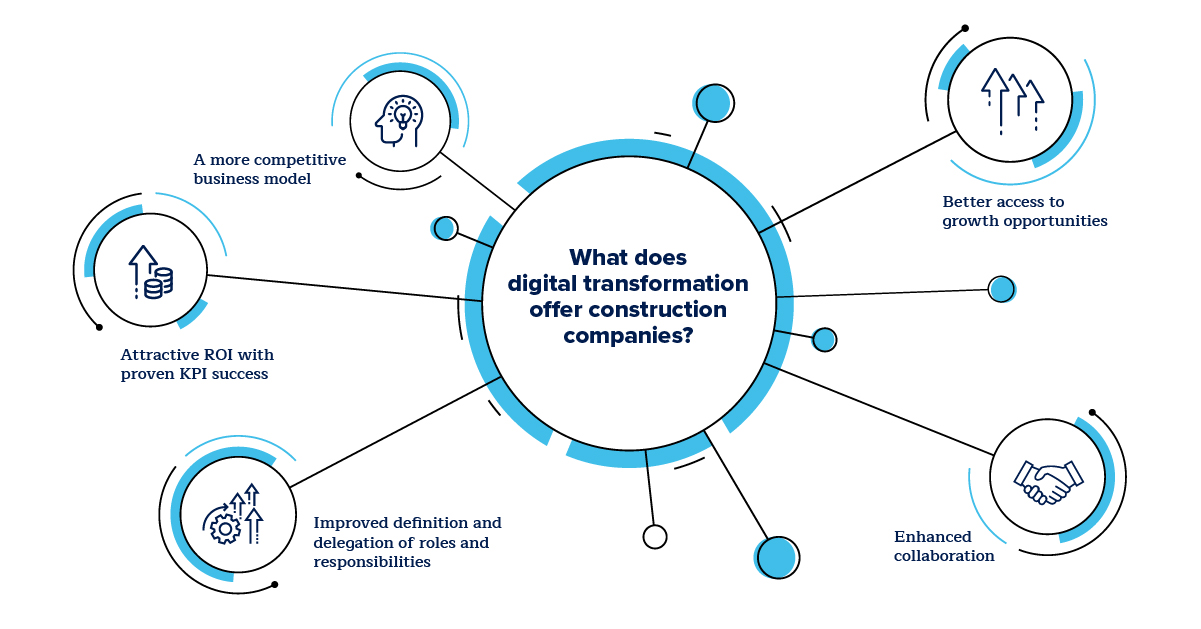
What are the 4 Main Areas of Digital Transformation in the Construction Industry?
The search term ‘digital transformation’ has been steadily on the rise over the last decade, when all industries were attempting to safeguard against disasters like the 2008 crash. 2014 marked the first year of full recovery and the start of a new digital revolution.
The digital domain is now accessible to everyone, with benefits in store across every industry. However, even as cloud and AI technologies become more mainstream, the process of full digital integration to achieve these benefits is daunting. Breaking it down into the 4 main areas of digital transformation can help overcome the initial overwhelm.
How does digital transformation in the construction industry work?
Construction spending in the US is forecast to grow from 1.6 trillion US dollars in 2021 to over 2 trillion by 2026. So why, in such a rapidly growing industry, should we worry about changing our ways? The answer is simple: to keep up.
Capital projects are steeped in risk. Tried-and-tested methods reign supreme, making new technology feel like a high-risk, low-reward idea. In reality though, digital transformation in the construction industry is the only way to stay competitive and grow with the market, and more and more businesses are beginning to catch on.
In the construction industry, digital transformation is not simply the implementation of digital technologies; instead, it requires a more holistic approach. Overhauling values, services, and long-term goals is just as important as recalibrating legacy systems. This is why we break it down into the 4 main areas of digital transformation.
What does digital transformation offer construction companies?
- Better access to growth opportunities
- Enhanced collaboration
- Improved definition and delegation of roles and responsibilities
- Attractive ROI with proven KPI success

What are the 4 main areas of digital transformation?
There is no single source of truth for this answer.
Microsoft, McKinsey & Co., and many others are in partial disagreement about how your strategy should be segmented — after all, digital transformation is not a one-size-fits-all process.
That said, fundamental ideas repeatedly appear, from which we can devise a best-fit solution for digital transformation in the construction industry.
Business Model Transformation
As more companies go digital, traditional business models are changing drastically in order to stay competitive. The plans and processes used to drive profit are adapting to new developments in the sector and governmental initiatives; for example, new sustainability targets. Equally, as the cost of materials fluctuates, demand for construction in specific industries increases, and budgets for public infrastructure are tightened – business models need to be agile to stay ahead of the curve.
Your business model is the first area to address when beginning digital transformation in the construction industry. It is your opportunity to establish your goals. Do you want to…
- Improve project turnaround times?
- Expand into a new market domain?
- Change your pricing strategy or integrate new costs?
- Update old business processes?
- Accommodate business growth?
- Achieve all of the above?
Once you have an objective, you can align your products, culture, and operations.
Domain Transformation
Sometimes known as ‘service transformation,’ domain transformation involves assessing what domains your business operates within. For a capital projects team within an organization, this means implementing a more effective management process to get more out of the spaces available.
What built environment management features would improve operations?
How can space be managed more efficiently?
How can you deliver more value to the business?
New technology offers potential in the realms of sustainability, cost-saving energy management, intelligent space delegation, and more. Digital transformation in this area should enable you to meet the specific needs of individual spaces more efficiently, while diversifying your portfolio of operational solutions.
Operational Transformation
Within every company, there are countless opportunities to streamline operational workflows, cut out repetitive tasks, and do away with outdated paper records using digital technology.
Many construction businesses have already started to improve their day-to-day operations using the visibility afforded by Business Information Modeling (BIM), but the possibilities do not stop there.
With so many shiny new IT systems available, it is easy to implement tech for tech’s sake; but before you overhaul your current systems, it’s important to assess them properly to find out what has been working and where the bottlenecks are originating. Then, take a process-first approach, addressing the pain points of your business and finding a digital solution that caters to that particular problem.
Pain points might include:
- Redundant or repetitive processes that could be automated
- Lack of data visibility for off-site management when making key decisions
- Slow workflows between on- and off-site contractors
- Wasted time and resources through disjointed project planning
- Out-of-date information that does not reflect business priorities
Fixing these drawbacks would result in faster progress on projects, thus, faster turnaround times — something that is reflected in costs and is invaluable to clients.
When implementing operational changes, the most important factor is communication. All stakeholders must be made aware of the changes and will need ongoing training.
This brings us to the third area of digital transformation in the construction industry.
Cultural Transformation
Business culture is usually something that is not explicitly defined, and for this reason, making any kind of change involves altering unspoken habits. To help ensure a smooth transition, management needs to be able to explain the desired change and exemplify those values.
Consider:
- What are the values held by your business?
- How do they need to be updated?
- How can digital technology facilitate these changes?
- How will your teams benefit?
- Company culture — Updated company values that align with your business model and goals
- Data hygiene — Better handling of business data, improved compliance management processes, and a data-driven business framework
Together, these benefits facilitate better use of capital and assets and, therefore, a higher ROI.

Securing team buy-in when making big changes is easier when you explain the new systems in terms of their specific benefits — how will these changes make jobs easier?
If, for example, you want to improve communication and set a new standard for project reporting, look at how cloud-based systems can encourage collaboration among your workforce, automate reporting, and simplify quality control.
Equally, if you want to boost morale and create a safer working environment, look at how risk management software can help you be more proactive with safety assessments.
What are the 4 main areas of digital transformation going to give you?
Done well, digital transformation in the construction industry leads to improvements in the following:
Business strategy — Accommodation of the full benefits of evolving technologies
Customer experience — A smoother, more individualized customer experience
Company culture — Updated company values that align with your business model and goals
Data hygiene — Better handling of business data, improved compliance management processes, and a data-driven business framework
Together, these benefits facilitate better use of capital and assets and, therefore, a higher ROI.
With so many benefits within arms’ reach, it’s vital that building owners implement a strategy that combines the 4 main areas of digital transformation. A successful digital transformation will make your building management strategy more responsive, agile, and intuitive.
To speak to an expert on digital transformation in the construction industry
The search term ‘digital transformation’ has been steadily on the rise over the last decade, when all industries were attempting to safeguard against disasters like the 2008 crash. 2014 marked the first year of full recovery and the start of a new digital revolution.
The digital domain is now accessible to everyone, with benefits in store across every industry. However, even as cloud and AI technologies become more mainstream, the process of full digital integration to achieve these benefits is daunting. Breaking it down into the 4 main areas of digital transformation can help overcome the initial overwhelm.
How does digital transformation in the construction industry work?
Construction spending in the US is forecast to grow from 1.6 trillion US dollars in 2021 to over 2 trillion by 2026. So why, in such a rapidly growing industry, should we worry about changing our ways? The answer is simple: to keep up.
Capital projects are steeped in risk. Tried-and-tested methods reign supreme, making new technology feel like a high-risk, low-reward idea. In reality though, digital transformation in the construction industry is the only way to stay competitive and grow with the market, and more and more businesses are beginning to catch on.
In the construction industry, digital transformation is not simply the implementation of digital technologies; instead, it requires a more holistic approach. Overhauling values, services, and long-term goals is just as important as recalibrating legacy systems. This is why we break it down into the 4 main areas of digital transformation.
What does digital transformation offer construction companies?
- Better access to growth opportunities
- Enhanced collaboration
- Improved definition and delegation of roles and responsibilities
- Attractive ROI with proven KPI success

What are the 4 main areas of digital transformation?
There is no single source of truth for this answer.
Microsoft, McKinsey & Co., and many others are in partial disagreement about how your strategy should be segmented — after all, digital transformation is not a one-size-fits-all process.
That said, fundamental ideas repeatedly appear, from which we can devise a best-fit solution for digital transformation in the construction industry.
Business Model Transformation
As more companies go digital, traditional business models are changing drastically in order to stay competitive. The plans and processes used to drive profit are adapting to new developments in the sector and governmental initiatives; for example, new sustainability targets. Equally, as the cost of materials fluctuates, demand for construction in specific industries increases, and budgets for public infrastructure are tightened – business models need to be agile to stay ahead of the curve.
Your business model is the first area to address when beginning digital transformation in the construction industry. It is your opportunity to establish your goals. Do you want to…
- Improve project turnaround times?
- Expand into a new market domain?
- Change your pricing strategy or integrate new costs?
- Update old business processes?
- Accommodate business growth?
- Achieve all of the above?
Once you have an objective, you can align your products, culture, and operations.
Domain Transformation
Sometimes known as ‘service transformation,’ domain transformation involves assessing what domains your business operates within. For a capital projects team within an organization, this means implementing a more effective management process to get more out of the spaces available.
What built environment management features would improve operations?
How can space be managed more efficiently?
How can you deliver more value to the business?
New technology offers potential in the realms of sustainability, cost-saving energy management, intelligent space delegation, and more. Digital transformation in this area should enable you to meet the specific needs of individual spaces more efficiently, while diversifying your portfolio of operational solutions.
Operational Transformation
Within every company, there are countless opportunities to streamline operational workflows, cut out repetitive tasks, and do away with outdated paper records using digital technology.
Many construction businesses have already started to improve their day-to-day operations using the visibility afforded by Business Information Modeling (BIM), but the possibilities do not stop there.
With so many shiny new IT systems available, it is easy to implement tech for tech’s sake; but before you overhaul your current systems, it’s important to assess them properly to find out what has been working and where the bottlenecks are originating. Then, take a process-first approach, addressing the pain points of your business and finding a digital solution that caters to that particular problem.
Pain points might include:
- Redundant or repetitive processes that could be automated
- Lack of data visibility for off-site management when making key decisions
- Slow workflows between on- and off-site contractors
- Wasted time and resources through disjointed project planning
- Out-of-date information that does not reflect business priorities
Fixing these drawbacks would result in faster progress on projects, thus, faster turnaround times — something that is reflected in costs and is invaluable to clients.
When implementing operational changes, the most important factor is communication. All stakeholders must be made aware of the changes and will need ongoing training.
This brings us to the third area of digital transformation in the construction industry.
Cultural Transformation
Business culture is usually something that is not explicitly defined, and for this reason, making any kind of change involves altering unspoken habits. To help ensure a smooth transition, management needs to be able to explain the desired change and exemplify those values.
Consider:
- What are the values held by your business?
- How do they need to be updated?
- How can digital technology facilitate these changes?
- How will your teams benefit?
- Company culture — Updated company values that align with your business model and goals
- Data hygiene — Better handling of business data, improved compliance management processes, and a data-driven business framework
Together, these benefits facilitate better use of capital and assets and, therefore, a higher ROI.

Securing team buy-in when making big changes is easier when you explain the new systems in terms of their specific benefits — how will these changes make jobs easier?
If, for example, you want to improve communication and set a new standard for project reporting, look at how cloud-based systems can encourage collaboration among your workforce, automate reporting, and simplify quality control.
Equally, if you want to boost morale and create a safer working environment, look at how risk management software can help you be more proactive with safety assessments.
What are the 4 main areas of digital transformation going to give you?
Done well, digital transformation in the construction industry leads to improvements in the following:
Business strategy — Accommodation of the full benefits of evolving technologies
Customer experience — A smoother, more individualized customer experience
Company culture — Updated company values that align with your business model and goals
Data hygiene — Better handling of business data, improved compliance management processes, and a data-driven business framework
Together, these benefits facilitate better use of capital and assets and, therefore, a higher ROI.
With so many benefits within arms’ reach, it’s vital that building owners implement a strategy that combines the 4 main areas of digital transformation. A successful digital transformation will make your building management strategy more responsive, agile, and intuitive.
To speak to an expert on digital transformation in the construction industry




